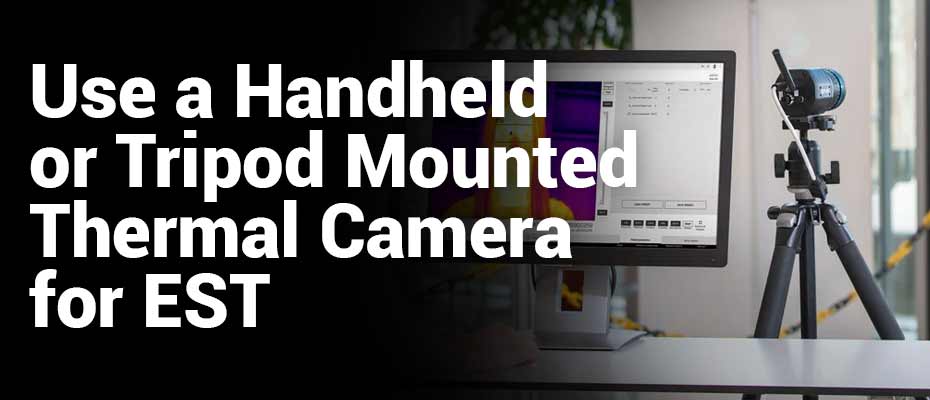
As the UK slowly begins to emerge from lockdown, with pubs, restaurants, hairdressers and some leisure facilities and tourist attractions able to re-open in England from the 4th July 2020 (provided they follow COVID Secure Guidelines)[1], it is important that social distancing and hygiene measures are implemented to prevent the potential spread of coronavirus. Skin-temperature-screening thermal imaging cameras offer an innovative, efficient and simple solution to detecting individuals who might have a fever, which is a common symptom of COVID-19.[2] They can be used to conduct non-contact temperature-screening at building entrances.
Skin-temperature-screening thermal cameras measure the surface temperature of human skin. Individuals with elevated skin temperature will trigger the thermal camera’s alarm and should have their body temperature verified using a medical/ body thermometer. Depending on company policy, persons who trigger the temperature alarm, and are proven to have an elevated body temperature, may be refused entry to prevent the potential spread of infection and could be required to self-isolate and/or undergo further medical testing.
The following steps should be observed to ensure the most accurate and reliable skin-surface temperature measurements using a handheld or tripod-mounted thermal camera.
1.) Prepare the Screening Environment
Set up the thermal camera indoors in a space that has an air temperature of 18°C to 24°C and a relative air humidity of 10% to 75%. Users should avoid setting up the thermal camera in areas that receive direct sunlight or that have significant air movement which may cause face cooling. Similarly, hot objects, such as monitors, overhead lights and table lamps, must not be present in the background of the thermal image as they can affect temperature readings.
Moreover, to improve the reliability of temperature measurements, individuals being screened must stand at the same distance from the camera. This can be achieved by clearly marking the screening spot. The distance between the thermal camera and the person being screened (the subject) varies depending on the camera’s resolution. Typically, cameras with an IR resolution of 320 x 240px should be set up 25 to 30cm from the subject (depending on the angle of the lens), whereas cameras with an IR resolution of 640 x 480px should be set up 1m from the subject (depending on the angle of the lens).
2.) Configure the Thermal Camera
The skin-temperature-screening thermal camera must be switched on and left to warm up at least thirty to ninety minutes (model dependent) prior to use.
Measurement parameters, including the temperature alarm/ tolerance, reflected apparent temperature, and emissivity, should be configured for human skin temperature measurements. Human skin has an emissivity of approximately 0.98.
Additionally, the thermal camera's focus must be adjusted and its measurement area set to ensure it takes the temperature at the corner of the person’s eye near the tear duct. This will provide a stable measurement closest to the individual’s ‘core-temperature’ as the area near the tear duct is above the carotid artery.
Furthermore, if using a black body, it should be placed in a position that occupies a space of at least 20x20px of the thermal image. This enables periodic recalibrations of the thermal imaging camera, improving the reliability and accuracy of temperature measurements.
3.) Perform Skin-Temperature Screening
Individuals must be screened one at time. As mentioned above, they should all stand on the same spot during temperature checks and should remain stationary during this process (usually a few seconds). Prior to being screened, individuals must remove head coverings, glasses, and face masks.
People that trigger the temperature alarm should be separated and have their body temperature verified using a medical thermometer. If a person is found to have an elevated body temperature, screening staff may choose to refuse him/her entry to the premises to prevent the potential spread of infection. Additionally, depending on the company’s policy, he/she may be required to self-isolate and/or undergo further medical testing.
It is important to note that skin-temperature-screening thermal cameras are NOT diagnostic tools and cannot be relied upon to detect all coronavirus carriers, particularly asymptomatic persons. Similarly, these cameras should not be used in place of other social distancing and hygiene measures and must be used alongside hand sanitiser stations and/or PPE and/or social distancing systems. Nevertheless, skin-temperature-screening thermal cameras can serve as an effective and efficient preliminary precaution.
[1] GOV.UK, PM announces easing of lockdown restrictions: 23 June 2020, last accessed 01 July 2020 < https://www.gov.uk/government/news/pm-announces-easing-of-lockdown-restrictions-23-june-2020>
[2] NHS, Check if you or your child has coronavirus symptoms, last accessed 01 July 2020 < https://www.nhs.uk/conditions/coronavirus-covid-19/symptoms/>


